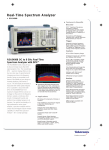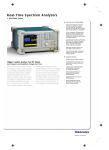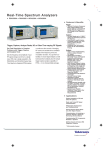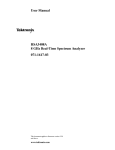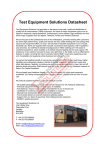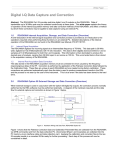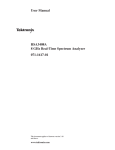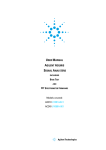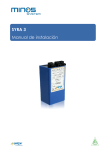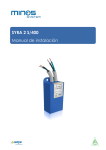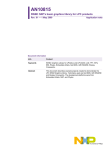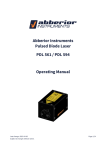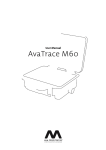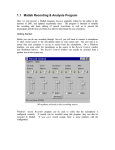Download Real-Time Spectrum Analyzers RSA3408A
Transcript
Real-Time Spectrum Analyzers RSA3408A Features & Benefits Trigger – Tektronix Exclusive 36 MHz*1 Frequency Mask Trigger Makes Easy Event-based Capture of Transient RF Signals by Triggering on Any Change in the Frequency Domain Capture – All Signals in Up to 36 MHz*1 Spans Are Seamlessly Captured into Memory – Up to 1.28 s Record Length at 36 MHz Span Provides Complete Analysis Over Time Without Making Multiple Acquisitions Analyze – Gain a Unique Understanding of Time-varying RF Signals – Enabling Engineers to View Signal Instabilities and Transients that They Never Knew Existed Trigger, Capture, Analyze WLAN, Radar, 3G or Other Time-varying RF Signals – 802.11a/b/g Measurement Suite – Comprehensive Pulsed Analysis Suite – General Purpose Digital Modulation Analysis – Spectrum Analyzer View for Traditional Wide Band Signal Analysis – Broad range of 3G Measurement Capabilities Applications High-resolution spectrogram reveals transient signal behavior that translates to rapid problem solving. Here, 500 kHz sidebands are revealed as part of the transient behavior of a hopping signal as it switches frequencies. Get Fast Resolution to Complex Problems with Enhanced Triggering, More Capture Bandwidth and Great New Analysis Tools See signals and events you’ve been missing with conventional analysis tools. With only a single acquisition, the RSA3408A Real-Time Spectrum Analyzer System Integration of WLAN, 3G and Other RF Systems Time-correlated, multi-domain view provides a new level of insight into design or operational problems not possible with conventional analysis solutions. Radar and Pulsed RF Signal Characterization RFID System Development and Troubleshooting Characterization of Interfering or Unknown Signals in Spectrum Monitoring and Surveillance (RTSA) captures a continuous time record of changing RF events and enables timecorrelated analysis in the frequency, time and modulation domains. You get the functionality of a vector signal analyzer, a wide band spectrum analyzer, plus the unique trigger-capture-analyze capability of RTSA – in one. Troubleshooting RF Components, Modules or Systems Getting Answers to Elusive EMI Diagnostic Problems *1 40 MHz bandwidth at baseband. Real-Time Spectrum Analyzers RSA3408A Trigger Unparalleled 36 MHz bandwidth Frequency Mask Trigger (FMT) makes it easy to capture transient, low duty-cycle or other difficult-to-capture signals. An FMT mask is simply configured using a mouse and it can be set up for one or many frequency bands within an analysis span. FMT can monitor for signal appearance/disappearance, or change in amplitude, frequency, bandwidth, spectral shape and more – all while the instrument user is working on another task. A Power Trigger, working in the time domain and at any Real-Time analysis span, can be armed to monitor for a user-set power threshold to be crossed during a moment in time. A power detector determines total power of all signals in a span which is compared to the user-set threshold. 2 Capture Capture once – make multiple measurements as needed. All signals in a Real-Time analysis span – including transients, low duty-cycle and other difficult-to-measure events – are captured together into RSA3408A deep memory where signal data can be accessed at the user’s convenience. Record lengths vary depending on span selected – up to 1.28 seconds at 36 MHz span, 51.2 seconds at 1 MHz span or 5120 seconds at 10 kHz span with Deep Memory Option 02. Real-Time capture of small signals is enhanced by –78 dBc third order IM and 66 dB 3GPP ACLR (TM1, 16 channel), plus very good phase noise performance and sensitivity. A solid performance front-end serves not only Real-Time and wide band Spectrum Analysis modes, but also on-board vector signal analysis functionality. Real-Time Spectrum Analyzer • www.tektronix.com/rsa Analyze Time-correlated multi-domain analysis provides engineers with unique insight to time-varying signal behavior resulting in fast analysis and problem solving. Timecorrelated measurements can be made across the frequency, time and modulation domains. The analysis display called Spectrogram has the ability to overlap individual spectra as close as 20 nsec, providing an intuitive view of signal changes over time, ideal for such things as frequency hopping, pulsed signals, modulation switching, settling time, bandwidth changes, relative timing of appearing and intermittent signals. The RSA3408A introduces analysis capabilities that advance productivity for engineers working on components or in RF system design, integration and performance verification, or operations engineers working in networks, spectrum monitoring or surveillance. Real-Time Spectrum Analyzers RSA3408A Example Applications Benefiting from Key RSA3408A Capabilities Analysis Feature RF Communications Systems WLAN Cell. Wireless + WLAN devices Radar, Pulsed Signal Transmission Surveillance, Spectrum Monitoring RFID Hi-res Spectrogram X X X X X X Multi-domain Correlation X X X X X X X X X X X 802.11a/b/g Analysis (Opt. 29) Cellular Standards Analysis (multiple options) General Purpose Digital Modulation Analysis (Opt. 21) X X X AM, FM, PM Analysis X X X Pulsed RF Signal Analysis X X X Pulse Spectrum X X X 2ASK, 2FSK Analysis + Manchester, Miller, NRZ Decoding (Opt. 21) X AM/AM, AM/PM and 1 dB Compression (Opt. 21) X Digital IQ Output (Opt. 05) X X X Removable HDD (Opt. 06) X X X X X X X X X Real-Time Spectrum Analyzer • www.tektronix.com/rsa 3 Real-Time Spectrum Analyzers RSA3408A Characteristics Trigger-related Trigger Mode – Free run (triggered by acquisition); Triggered (triggered by event), Single or Continuous. Trigger Event Source – Power (span BW); Frequency Mask (Opt. 02); External. Pre-/Post-Trigger Setting – Trigger position settable within 0 to 100% of total acquisition length. Trigger Marker Position Timing Uncertainty (Power and External Trigger) – ±2 sample points. Power Trigger Level Range – 0 dBfs*1 to –40 dBfs. *1 4 dBfs: dB relative to full scale. Frequency Mask Trigger (Opt. 02) Mask Resolution – 1 bin. Level Range – 0 dBfs to –60 dBfs*1 at 10 dB/div vertical scale. Bandwidth – Up to 36 MHz: Start frequency ≥40 MHz. Up to 40 MHz: Start frequency <40 MHz. Real-Time Event Detection Bandwidth (1024 point FFT) – 100% probability of event detection at all real-time spans. Minimum Event Duration – 1 frame time; events lasting less than one frame time will result in degraded Frequency Mask Trigger accuracy. Mask Shape – User-defined. Minimum Horizontal Mask Setting Resolution – <0.2% of span. Uncertainty – ±2 frames. Real-Time Spectrum Analyzer • www.tektronix.com/rsa External Trigger Threshold Voltage – –1.5 V to +1.5 V. Threshold Voltage Setting Resolution – 0.1 V. Input Impedance – >2 kΩ. Trigger Output Voltage (Output Current <1 mA) – HIGH: >2.0 V; LOW: <0.4 V. Capture-related Real-Time Capture Bandwidth – 36 MHz, RF; 40 MHz, baseband; 40 MHz using Opt. 03 IQ inputs. A/D Converter – 102.4 MS/s, 14 bits. Minimum Acquisition Length in RTSA/Time/ Demod Modes – 1024 samples. Maximum Acquisition Length in RTSA/Time/ Demod Modes – 16,384,000 samples; 65,636,000 samples, Opt. 02. Acquisition Length Setting Resolution in RTSA/ Time/Demod Modes – 1024 samples. Acquisition Memory Size – 16.4 Msamples; 65.6 Msamples, Opt. 02. Block Size (number of frames) – 1 to 16,000; 1 to 64,000, Opt. 02. Real-Time Spectrum Analyzers RSA3408A Memory Depth (time) and Maximum Time Resolution Span Sample Rate (For I and Q) Record Length Record Length (Option 02) Spectrum Frame (Time) Max Time (Resolution) 40 MHz (baseband) 51.2 MS/s 0.32 s 1.28 s 20 µs 20 ns 36 MHz 51.2 MS/s 0.32 s 1.28 s 20 µs 20 ns 20 MHz 25.6 MS/s 0.64 s 2.56 s 40 µs 40 ns 10 MHz 12.8 MS/s 1.28 s 5.12 s 80 µs 80 ns 5 MHz 6.4 MS/s 2.56 s 10.24 s 160 µs 160 ns 2 MHz 2.56 MS/s 6.4 s 25.6 s 400 µs 400 ns 1 MHz 1.28 MS/s 12.8 s 51.2 s 800 µs 800 ns 500 kHz 640 kS/s 25.6 s 102.4 s 1.6 ms 1.6 µs 200 kHz 256 kS/s 64 s 256 s 4.0 ms 4.0 µs 100 kHz 128 kS/s 128 s 512 s 8.0 ms 8.0 µs 50 kHz 64 kS/s 256 s 1024 s 16 ms 16 µs 20 kHz 25.6 kS/s 640 s 2560 s 40 ms 40 µs 10 kHz 12.8 kS/s 1280 s 5120 s 80 ms 80 µs 5 kHz 6.4 kS/s 2560 s 10240 s 160 ms 160 µs 2 kHz 2.56 kS/s 6400 s 25600 s 400 ms 400 µs 1 kHz 1.28 kS/s 12800 s 51200 s 800 ms 800 µs 500 Hz 640 S/s 25600 s 102400 s 1.6 s 1.6 ms 200 Hz 256 S/s 64000 s 256000 s 4.0 s 4 ms 100 Hz 128 S/s 128000 s 512000 s 8.0 s 8 ms Real-Time Spectrum Analyzer • www.tektronix.com/rsa 5 Real-Time Spectrum Analyzers RSA3408A Analysis-related Measurement Functions by Mode Mode Measurements SA Channel Power, Adjacent Channel Power Ratio, Occupied Bandwidth, Emission Bandwidth, Carrier-to-Noise Ratio, Carrier Frequency, Spur Search, db/Hz Marker, dBc/Hz Marker RTSA Channel Power, Adjacent Channel Power Ratio, Occupied Bandwidth, Emission Bandwidth, Carrier-to-Noise Ratio, Carrier Frequency, Spur Search Time IQ vs. Time, Power vs. Time, Frequency vs. Time, CCDF, Crest Factor Pulse Measurements: Pulse Width, Pulse Peak Power, On/Off Ratio, Pulse Ripple, Pulse Repetition Interval, Duty Cycle, Pulse-Pulse Phase, Channel Power, OBW, EBW, Frequency Deviation (Min pulse length, 20 samples; Max pulse length, 16,384 samples), Channel Power, Frequency Deviation, and EBW (less than 16,384 points) Analog Demod IQ vs. Time, AM Depth, FM Deviation, PM Deviation, Pulse Spectrum General Purpose Digital Demod (Option 21) Error vs. Time: EVM, Magnitude Error, Phase Error Error: Waveform Quality ρ, Frequency Error, Origin Offset PDF: Probability of Occurrence vs. Power Level AM-AM, AM-PM, 1 dB Compression, Crest Factor Views by Mode Mode SA Views Spectrum SA/Spectrogram Spectrum, Spectrogram RTSA Spectrum, Spectrogram Time Overview: Power vs. Time, Spectrogram Sub View: Spectrum Main View: Measurement Result Analog Demod Overview: Power vs. Time, Spectrogram Sub-view: Spectrum Main view: Measurement Result Digital Demod (Option 21) Overview: Power vs. Time, Spectrogram Sub-view or Main View: Vector diagram Constellation diagram, data displayed at symbol times Error vector diagram Eye Diagram, adjustable, 1 to 16 symbols Trellis, adjustable, 1 to 16 symbols I/Q vs. Time, EVM vs. Time Symbol Table, binary, octal or hexadecimal – Manchester, Miller and NRZ decoding available for 2ASK and 2FSK modulation AM-AM display AM-PM display CCDF display PDF display 6 Real-Time Spectrum Analyzer • www.tektronix.com/rsa RSA3408A Screen layout, to identify analysis view locations as described in the table on the left. Real-Time Spectrum Analyzers RSA3408A QPSK EVM (%), Typical Symbol rate, per second 100 k 1M 4M 10 M 20 M CF = 1 GHz 0.5 0.5 0.6 0.9 1.6 CF = 2 GHz 0.5 0.5 0.6 0.9 1.8 CF = 3 GHz 0.5 0.5 0.6 0.9 1.8 CF = 5 GHz 0.7 0.7 0.9 1.6 2.4 /4 DQPSK EVM (%), Typical Symbol rate, per second 100 k 1M 4M 10 M 20 M CF = 1 GHz 0.6 0.6 0.6 0.9 1.8 CF = 2 GHz 0.6 0.6 0.6 0.9 1.8 CF = 3 GHz 0.6 0.6 0.6 0.9 1.8 CF = 5 GHz 0.7 0.7 0.9 1.6 2.4 Measurement Speed Traces, Displays, Detectors Digital (Option 21) Screen Update Rate – 2 MHz Span, AUTO RBW : 19.4/sec. Remote Measurement Rate and GPIB Transfer Rate (2 MHz span, auto RBW, spectrum data) – 1.87 Waveforms/sec, or 6,000 Samples/sec. RF Center Frequency Switching Time – <10 ms for 10 MHz frequency change; 500 ms for 3 GHz frequency change. Traces – Two traces, Spectrum Analyzer Mode. Displays – Up to three time-correlated, userselected displays. Detector – RMS. Trace Types – Normal (RMS), Average, Max Hold, Min Hold. Display Detection – Max, Min, Max/Min. Modulation Formats – BPSK, QPSK, /4 DQPSK, OQPSK, 8PSK, 16QAM, 32QAM, 64QAM, 128QAM, 256QAM, GMSK, GFSK, 2ASK, 2FSK. Analysis Period – Up to 7680 sample points. Filter Types – Measurement filters: Square root raised cosine, none. Reference filters: Raised cosine, Gaussian, none. Alpha/B*T Range – 0.0001 to 1, 0.0001 step. Modulation Analysis Analog AM Minimum Input Level – –40 dBfs*1, typical. PM Minimum Input Level – –40 dBfs, typical. PM Scale, Max, Min – ±180º. FM Minimum Input Level – –40 dBfs, typical. Range – ±Span/2 from center frequency. *1 dBfs: dB relative to full scale. Demodulation Accuracy Analog AM (–10 dBfs signal, input at CF, 10 to 60% modulation depth) – ±2%. PM (–10 dBfs signal, input at CF) – ±3º. FM (–10 dBfs signal, input at CF) – ±1% of span. Digital (Option 21) The following tables are examples of typical digital demodulation accuracy: Real-Time Spectrum Analyzer • www.tektronix.com/rsa 7 Real-Time Spectrum Analyzers RSA3408A 16/64 QAM EVM (%), Typical Symbol rate, per second 100 k 1M 4M 10 M 20 M CF = 1 GHz 0.5 0.5 0.5 0.7 1.2 CF = 2 GHz 0.5 0.5 0.5 0.7 1.2 CF = 3 GHz 0.5 0.5 0.5 0.7 1.2 CF = 5 GHz 0.9 0.5 0.7 1.3 2.0 Stability Noise Sidebands, dBc/Hz Offset Spec At 1 GHz CF Typical Spec At 2 GHz CF Typical Spec At 6 GHz CF Typical 1 kHz –105 –107 –103 –105 –97 –99 10 kHz –110 –112 –109 –111 –106 –108 20 kHz –110 –112 –109 –111 –106 –108 30 kHz –110 –112 –109 –111 –106 –108 100 kHz –112 –115 –112 –115 –111 –113 1 MHz –132 –135 –132 –135 –132 –134 5 MHz –138 –140 –138 –140 –137 –139 7 MHz –138 –140 –138 –140 –137 –139 10 MHz –138 –140 –138 –140 –137 –139 RF Performance IF Flatness – Frequency Frequency 2 GHz 5 GHz Frequency Range – DC to 8 GHz. Center Frequency Setting Resolution – 0.1 Hz. Frequency Marker Readout Accuracy, Baseband – ±(RE x MF + 0.001 x Span + 0.2) Hz. Frequency Marker Readout Accuracy, RF – ±(RE x MF + 0.001 x Span + 2) Hz. RE: Reference Frequency Error. MF: Marker Frequency (Hz). Span Accuracy – ±1 bin. RBW Filter Bandwidth Accuracy – 0.1%. Reference Frequency – Aging per Day – 1 x 10–9 (after 30 days of operation). Flatness ±0.3 dB ±0.3 dB IF Phase Linearity – Frequency 2 GHz 5 GHz Bandwidth ≤36.6 MHz ≤36.6 MHz Flatness ±2.5° ±2.5° IF Filter Bandwidth – Resolution Bandwidth Range – 1 Hz to 10 MHz, automatically selected or user-defined. Accuracy – Within 6.0% ±0.1%. Shape Characteristic – Gaussian, <5:1 shape factor (3:60 dB); Rectangular, Nyquist, Root Nyquist shapes may also be selected. Aging per Year – 1 x 10–7 (after 30 days Minimum Settable RBW (Extended Resolution ON) of operation). Frequency Span >2 GHz 1 GHz <Span ≤ 2 GHz 500 MHz <Span ≤ 1 GHz 20 MHz <Span ≤ 500 MHz 500 kHz <Span ≤ 20 MHz 200 kHz <Span ≤ 500 kHz 100 kHz <Span ≤ 200 kHz 50 kHz <Span ≤ 100 kHz 20 kHz <Span ≤ 50 kHz 10 kHz <Span ≤ 20 kHz 5 kHz <Span ≤ 10 kHz 2 kHz <Span ≤ 5 kHz 1 kHz <Span ≤ 2 kHz 100 Hz <Span ≤ 1 kHz Temperature Drift – 1 x 10–7 (10 to 40 ºC). Total Frequency Error – 2 x 10–7 (within one year after calibration). Reference Output Level – >0 dBm. External Reference Input – 10 MHz, –10 dBm to + 6 dBm. Frequency Span – Range, Spectrum Analyzer Mode – 50 Hz to 3 GHz, (Start Frequency ≥40 MHz). 0 Hz to 40 MHz, (Stop Frequency <40 MHz). Range, Real-Time Spectrum Analyzer Mode – 100 Hz to 20 MHz, 36 MHz (RF). 0 Hz to 40 MHz, (Baseband). 8 Bandwidth ≤36.6 MHz ≤36.6 MHz Real-Time Spectrum Analyzer • www.tektronix.com/rsa RBW 100 kHz 50 kHz 20 kHz 10 kHz 1 kHz 500 Hz 200 Hz 100 Hz 50 Hz 20 Hz 10 Hz 5 Hz 2 Hz 1 Hz Noise Bandwidth Range, RTSA Mode – 250.545 mHz to 100.218 kHz. FFT Performance – Number of samples per frame - 64 to 8192 (65,536 samples per frame, extended resolution). Window types - Rectangular, Parzen, Welch, SineLobe, Hanning, Sine-Cubed, Sine-To-The 4th, Hamming, Blackman, Rosenfield, Blackman-Harris 3A, Blackman-Harris 3B, Blackman-Harris 4A, Blackman-Harris 4B, FlatTop. Real-Time Spectrum Analyzers RSA3408A Frequency Response, 20 ºC to 30 ºC, RF ATT ≥10 dB Frequency Spec Typical 100 kHz to 40 MHz ±0.5 dB ±0.3 dB 40 MHz to 3.5 GHz ±1.2 dB ±0.5 dB 3.5 GHz to 6.5 GHz ±1.7 dB ±1.0 dB 5 GHz to 8 GHz ±1.7 dB ±1.0 dB Residual FM – 2 Hzp-p, typical. Amplitude Measurement Range – Displayed average noise level to MAX safe input. Input Attenuator Range – RF/baseband input – 0 dB to 55 dB, 5 dB step. IQ Input (Opt 03) – 0 dB to 35 dB, 5 dB step. Input Attenuator Setting Uncertainty (at 100 MHz, 10 dB ATT, 20 ºC to 30 ºC) – ±0.2 dB. Maximum Safe Input Level – Average Continuous (RF band, RF ATT ≥10 dB) – +30 dB. MAX DC Voltage – ±0.2 V, RF; ±5 V, Baseband; ±5 V, IQ input, Opt. 03. Log Display Range – 10 µdB/div to 10 dB/div. Linear Display Scale – 10 divisions. Linear Display Units – dBm, dBµV, V, Watts, Hz for FM Demod, Degrees for PM Demod. Marker Readout Resolution, Log – 0.01 dB. Marker Readout Resolution, Linear – 0.001 µV. Absolute Amplitude Accuracy at Calibration Point (baseband, at 25 MHz, –10 dBm signal, 0 dB ATT, 20 ºC to 30 ºC) – ±0.3 dB. Absolute Amplitude Accuracy at Calibration Point (RF, at 100 MHz, –20 dBm signal, 0 dB ATT, 20 ºC to 30 ºC) – ±0.5 dB. Reference Level Setting Range – 1 dB step, RF, –50 dBm to +30 dBm; 5 dB step, baseband, –30 dBm to +20 dBm; 5 dB step, IQ, –10 dBm to +20 dBm. Reference Level Accuracy (–10 dBm to –50 dBm at 100 MHz, 10 dB ATT, 20 ºC to 30 ºC) – ±0.2 dB. Level Linearity in Display Range – ±0.2 dB, spec; ±0.12 dB, typical. Spurious Response 1 dB Compression (RF ATT = 0 dB, 2 GHz CF) – +2 dBm. 3rd Order Inter-modulation Distortion (Ref Level = +5 dBm, RF ATT: adjusted for optimum, total signal power = –7 dBm, CF = 2 GHz) – –78 dBc. 2nd Harmonic Distortion (–30 dBm tone at input mixer, 10 MHz to 1750 MHz) – –65 dBc, typical. Displayed Average Noise Level, Specified, dBm/Hz Frequency 10 MHz 2 GHz 3 GHz 7 GHz Spec –151 –150 –150 –142 Displayed Average Noise Level, Typical, dBm/Hz Frequency 1 kHz to 10 kHz 10 kHz to 10 MHz 10 MHz to 100 MHz 100 MHz to 1 GHz 1 GHz to 2 GHz 2 GHz to 3 GHz 3 GHz to 5 GHz 5 GHz to 8 GHz Typical –144 –151 –151 –150 –150 –150 –142 –142 Real-Time Spectrum Analyzer • www.tektronix.com/rsa 9 Real-Time Spectrum Analyzers RSA3408A Residual Response Frequency Spec 1 to 40 MHz (Span=20 MHz, Ref Lvl =–30 dBm, RBW=100 kHz) –93 dBm 0.5 to 3.5 GHz (Span=3 GHz, Ref Lvl=–30 dBm, RBW=100 kHz) –90 dBm 3.5 to 6.5 GHz (Span=3 GHz, Ref Lvl=–30 dBm, RBW=100 kHz) –85 dBm 3.5 to 8 GHz (Span=3 GHz, Ref Lvl=–30 dBm, RBW=100 kHz) –85 dBm Spurious Response with Signal Frequency Spec 0 MHz (Span=10 MHz, Ref Lvl=0 dBm, RBW–50 kHz, Signal Frequency=25 MHz, Signal Level=–5 dBm) –73 dBc 2 GHz (Span=10 MHz, Ref Lvl=0 dBm, RBW–50 kHz, Signal Frequency=2 GHz, Signal Level=–5 dBm) –73 dBc 5 GHz (Span=10 MHz, Ref Lvl=0 dBm, RBW–50 kHz, Signal Frequency=5 GHz, Signal Level=–5 dBm) –70 dBc 7 GHz (Span=10 MHz, Ref Lvl=0 dBm, RBW–50 kHz, Signal Frequency=7 GHz, Signal Level=–5 dBm) –70 dBc VSWR, RF ATT >10 dB Frequency 300 kHz to 10 MHz 10 MHz to 3 GHz Spec Typical — <1.4:1 — <1.3:1 2.5 GHz <1.4:1 — 7.5 GHz <1.8:1 — 10 Real-Time Spectrum Analyzer • www.tektronix.com/rsa Real-Time Spectrum Analyzers RSA3408A Inputs and Outputs General Characteristics Front Panel Temperature Range – Operating: +10 ºC to +40 ºC. Storage: –20 ºC to +60 ºC. Warm-up Time – 20 min. Operating Altitude – Operating: up to 3000 m (10,000 ft.). Non-operating: up to 12,000 m (40,000 ft.). Safety and EMI Compatibility – UL 61010-1; CSA C22.2 No. 61010-1-04; IEC61010, second edition (Self Declaration). Low Voltage Directive 73/23/EEC, amended by 93/68/EEC; EN61010-1: 2001 Safety requirements for electrical equipment for Measurement control and laboratory use. EC Council EMC Directive 89/336/EEC, amended by 93/68/EEC; EN61326-1: 1997 Product Family Standard for Electrical Equipment for Measurement, Control, and Laboratory Use-EMC Requirements. Electromagnetic Compatibility Framework:1992 AS/NZS 2064.1/2(Industrial, Scientific, and Medical Equipment). Power Requirements – 100 VAC to 240 VAC, 47 Hz to 63 Hz. Power Consumption – 400 VA max. Data Storage – Internal HDD (40 GB), USB port, FDD. Weight, without options – 20 kg, 44 lbs. Dimensions – Without bumpers and feet: 215 mm (H) x 425 mm (D) x 425 mm (W). With bumpers and feet: 238 mm (H) x 470 mm (D) x 445 mm (W). Calibration Interval – One year. Warranty – One year. GPIB – SCPI-compatible. Input Connectors – N type, RF/baseband; BNC type, IQ, Opt. 03. Input Impedance – 50 Ω. Preamp Power Connector – Lemo, 6 poles: pin 1 = NC; pin 2 = ID1; pin 3 = ID2; pin 4 = –12 V; pin 5 = GND; pin 6 = +12 V. Rear Panel Digital IQ Output (Option 05) – Connector Type – MDR (3M) 50 pin x 2. Data Output – I data: 16 bit LVDS; Q data: 16 bit LVDS. Control Output – Clock: LVDS, MAX 51.2 MHz. Control Input – IQ data output enabled, connecting GND enables output of IQ data. Clock Rising Edge to Data Transition Time (hold time) – >5 ns. Data Transition to Clock Rising Edge (setup time) – >5 ns. Data from Option 05 requires application of correction factors to IQ data to achieve similar RF performance to RSA3408A. 10 MHz REF OUT – 50 Ω, BNC, >–3 dBm. 10 MHz REF IN – 50 Ω, BNC, –10 dBm to +6 dBm. EXT TRIG IN – Ext Trig, BNC, High: 1.6 to 5.0 V, Low: 0 to 0.5 V. GPIB Interface – IEEE 488.2. TRIGGER OUT – 50 Ω, BNC, High >2.0 V, Low: <0.4 V (output current 1 mA). Side Panel LAN Interface (Ethernet – 10/100 Base-T (Std.). Serial Interface – USB 1.1, two ports. VGA Output – VGA compatible, 15 DSUB. Ordering Information RSA3408A Real-Time Spectrum Analyzer, DC – 8 GHz. Includes: User manual, Programmer’s manual, power cord, BNC-N adapter, USB Keyboard and Mouse. Options Opt. 1A – External Preamp, 100 MHz to 3 GHz, 20 dB gain, 6.5 dB Noise Figure at 2 GHz, Typical. Opt. 02 – 65.5 MSample Deep Memory, Frequency Mask Trigger. Opt. 03 – IQ, Differential IQ Inputs. Opt. 05 – Digital IQ Output. Opt. 06 – Removable HDD. Opt. 21 – General Purpose Modulation Analysis. Opt. 23 – W-CDMA Uplink Analysis. Opt. 24 – GSM/EDGE Analysis. Opt. 25 – CDMA 1X Forward/Reverse Link Analysis. Opt. 26 – 1X EVDO Forward/Reverse Link Analysis. Opt. 27 – 3GPP Release 5 Downlink (HSDPA) Analysis. Opt. 28 – TD-SCDMA Analysis. Opt. 29 – WLAN 802.11a/b/g Analysis. Opt. 1R – Rackmount. Real-Time Spectrum Analyzer • www.tektronix.com/rsa 11 Real-Time Spectrum Analyzers Contact Tektronix: ASEAN / Australasia / Pakistan (65) 6356 3900 RSA3408A Austria +41 52 675 3777 Balkan, Israel, South Africa and other ISE Countries +41 52 675 3777 Belgium 07 81 60166 Accessories Upgrades RSA34RHD – Extra 40 GB Removable Hard Drive for use with Opt. 06. RSA34UP International Power Plugs Opt. A0 – North America power. Opt. A1 – Universal EURO power. Opt. A2 – United Kingdom power. Opt. A3 – Australia power. Opt. A4 – 240 V, North America power. Opt. A5 – Switzerland power. Opt. A6 – Japanese power. Opt. A10 – China power. Opt. A99 – No Power Cord. Service Opt. C3 – Calibration Service 3 Years. Opt. C5 – Calibration Service 5 Years. Opt. D1 – Calibration Data Report. Opt. D3 – Calibration Data Report 3 Years (with Opt. C3). Opt. D5 – Calibration Data Report 5 Years (with Opt. C5). Opt. R3 – Repair Service 3 Years. Opt. R5 – Repair Service 5 Years. Brazil & South America 55 (11) 3741-8360 Canada 1 (800) 661-5625 Opt. 02 – 65.5 MSample Deep Memory, Frequency Mask Trigger. Opt. 03 – IQ, Differential IQ Inputs. Opt. 05 – Digital IQ Output. Opt. 06 – Removable HDD. Opt. 21 – General Purpose Modulation Analysis. Opt. 23 – W-CDMA Uplink Analysis. Opt. 24 – GSM/EDGE Analysis. Opt. 25 – cdma2000 1X Forward/Reverse Link Analysis. Opt. 26 – 1X EVDO Forward/Reverse Link Analysis. Opt. 27 – 3GPP Release 5 Downlink (HSDPA) Analysis. Opt. 28 – TD-SCDMA Analysis. Opt. 29 – WLAN 802.11a/b/g Analysis. Opt. IF – Installation labor. Opt. IFC – Installation labor + calibration. Central East Europe, Ukraine and the Baltics +41 52 675 3777 Central Europe & Greece +41 52 675 3777 Denmark +45 80 88 1401 Finland +41 52 675 3777 France & North Africa +33 (0) 1 69 86 81 81 Germany +49 (221) 94 77 400 Hong Kong (852) 2585-6688 India (91) 80-22275577 Italy +39 (02) 25086 1 Japan 81 (3) 6714-3010 Luxembourg +44 (0) 1344 392400 Mexico, Central America & Caribbean 52 (55) 56666-333 Middle East, Asia and North Africa +41 52 675 3777 The Netherlands 090 02 021797 Norway 800 16098 People’s Republic of China 86 (10) 6235 1230 Poland +41 52 675 3777 Portugal 80 08 12370 Republic of Korea 82 (2) 528-5299 Russia & CIS 7 095 775 1064 South Africa +27 11 254 8360 Languages Spain (+34) 901 988 054 Opt. L0 – English User/Programmers Manuals. Opt. L5 – Japanese User/Programmers Manuals. Sweden 020 08 80371 Switzerland +41 52 675 3777 Taiwan 886 (2) 2722-9622 United Kingdom & Eire +44 (0) 1344 392400 USA 1 (800) 426-2200 For other areas contact Tektronix, Inc. at: 1 (503) 627-7111 Updated 15 June 2005 Our most up-to-date product information is available at: www.tektronix.com Product(s) are manufactured in ISO registered facilities. Product(s) complies with IEEE Standard 488.2-1987 with SCPI conformance. Copyright © 2005, Tektronix, Inc. All rights reserved. Tektronix products are covered by U.S. and foreign patents, issued and pending. Information in this publication supersedes that in all previously published material. Specification and price change privileges reserved. TEKTRONIX and TEK are registered trademarks of Tektronix, Inc. All other trade names referenced are the service marks, trademarks or registered trademarks of their respective companies. 6/05 HB/WOW 37W-18380-1












